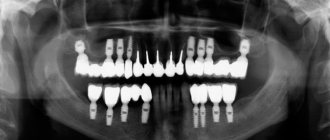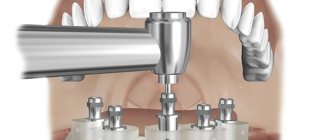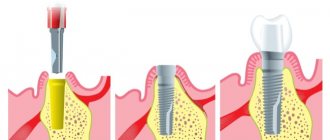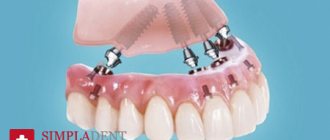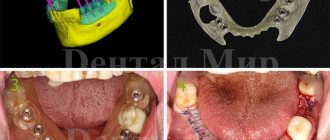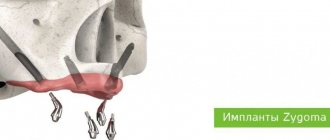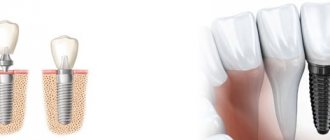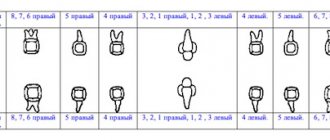Publication date: 03/19/2021
It seems that dental implantation takes a long time and it is impossible to make teeth turnkey in 1 day. However, innovative technologies and modern materials are capable of even this. Restoring lost teeth and making them indistinguishable from real ones is a feasible task for today’s medicine.
A beautiful, attention-grabbing smile is an indicator of health and status. It gives self-confidence to its owner. But what to do if not all the teeth were saved, or most of them are destroyed or are subject to severe caries. In such cases, treatment and subsequent implantation come to the rescue. This way you can get your perfect smile back in 1 day.
Indications and contraindications for installing implants in one day
This type of prosthetics allows you to either restore an entire row of teeth or make a prosthesis for just one tooth. This method is recommended for:
- periodontal disease
- irritation of bone tissue
- receding gums
- complete absence of teeth
This technology allows you to insert teeth in one day and immediately return a beautiful smile and the ability to eat comfortably.
One-time implantation is especially good in cases of complete or almost complete absence of teeth, when there is no time for a long wait and you want to quickly return to a full life.
There are certain situations in which implantation in one day is not possible. A preliminary examination will help identify these indications, without which medical intervention should not begin. Contraindications to dental implantology are:
- advanced osteoporosis
- oncological diseases
- connective tissue pathologies
- poor blood clotting
- immune system disorders
- decompensated diabetes
- acute infectious diseases
- pregnancy and lactation
If the above indications are present, the doctor will recommend an alternative method of restoring the dentition.
Stages of dental implantation in one day
Dental implantation in one day is carried out according to the following algorithm:
- Preparatory stage. At this step, an examination of the oral cavity, a CT scan of the dentoalveolar system, laboratory tests, drawing up a treatment plan (selection of dental implants with suitable parameters, production of a navigation template, recreating the result in three-dimensional format);
- Fixation of implants. Extraction of defective units, installation of dental systems, suturing of gingival tissues, fixation of the device to form the correct gingival contour, making impressions for temporary prosthetic structures;
- Installation of crowns or dentures on implants. Secondary inspection, fixation of adapters and temporary crowns.
It is possible to take dental impressions during the first visit if the patient has completed all the necessary tests in advance and there are no restrictions. This allows both dental implants and temporary prosthetic devices to be fixed in one day during a secondary visit to a specialist. In this case, a third visit to the dentist is necessary for a follow-up examination.
It is important to note that the fixation of permanent prosthetic structures made of ceramic or zirconium material is performed only after the end of the osseointegration period. As a rule, after 3-5 weeks.
The specialists of the Implantmaster clinic use modern methods of teeth reconstruction in their work. In particular, we use the latest scanner to obtain a digital impression of the teeth; We focus on a new type that allows us to obtain high-precision images with a lower degree of radiation; if necessary, we carry out atraumatic extraction of teeth and model the future result in three-dimensional format using special computer programs.
Stages of treatment
Implantation in 1 day is prosthetics immediately after the installation of implants. The issue of aesthetic and practical function of teeth is resolved in a short time. This operation does not require bone grafting. Implants can be installed not only in the spongy substance, but also in deeper layers of bone. In addition, the pins can be placed at an angle. This technology allows you to avoid injury to nerves, blood vessels and paranasal sinuses.
The installation of implants is carried out in one visit to the dentist, but to achieve the final result, this procedure requires preparatory measures. The whole operation takes place in several stages:
- At the first session, the doctor conducts diagnostics, determines the current condition of the patient’s teeth, possible contraindications, and performs a computed tomography scan. If preliminary treatment is necessary, it must be carried out. Otherwise, it will not be possible to install new teeth. At the same appointment, a model of future prostheses is created. The waiting period for future implants ranges from 1 to 7 days. Next, the doctor chooses the method of performing the procedure, selects the pins and makes the crowns that will be installed.
- The second stage is the work of installing the metal pins themselves. It is performed under anesthesia in one procedure. At the site where the implants are installed, an incision is made in the gum and pins are screwed into the prepared recess. Then the gum is sutured. Next, a temporary prosthesis is placed on the implanted implants. It is made of acrylic, so it is quite light, which contributes to comfortable wear and rapid healing.
The permanent prosthesis is installed 6-12 months after implantation. This time is enough for the implant to fuse with the bone.
What prostheses can be installed on the 4th implant?
Unlike expensive prosthetics that use 6 or more implants to support the prosthesis, the “All on 4” technology, due to the special placement of implants, allows you to optimally distribute the chewing load for a prosthesis with a length of up to 12 teeth. The cantilever parts of the prosthesis are minimal.
Immediately after installation of the implants, a temporary prosthesis must be used. This is a lightweight acrylic prosthesis that allows you to chew food comfortably, looks good in the mouth, but breaks under excessive chewing loads to protect implants that have not yet taken root. The period of wearing a temporary prosthesis is 4–6 months. This time is required for complete osseointegration of the implants with the bone.
A permanent prosthesis can be removable or non-removable, differ in the method of fastening, the design of the frame (providing strength), the materials that provide external aesthetics, the shape of the teeth (standard or customized) and the materials from which they are made.
Which implantation method is best to use?
In modern dentistry, there are several methods of implantation with immediate loading. The most popular and affordable is all-on-4. With this protocol, the dentition is replaced with only four pins. Two of them are implanted vertically and two on the sides at an angle.
Using this technology, 12 dental units can be restored at a time. It is well suited for people who are missing all the teeth on one or both jaws. Or they have been preserved, but in such a condition that they only need to be removed. In this case, implantation and removal can be carried out in one session, and the pins can be installed in the holes remaining after extraction.
The all-on-4 protocol is feasible in case of good preservation of bone tissue and in the absence of gum damage. This method is also used for periodontitis and periodontal disease.
A more advanced method of all-on-4 prosthetics is the all-on-6 protocol. The difference lies in the number of pins implanted. The use of two additional implants increases the reliability of the design as a whole. In addition, the use of all-on-6 is possible even with severe atrophy of the spongy substance due to the fact that the pins are installed in a deeper layer of bone.
What is special about the “All on 4” method?
In the anterior part of the jaw, where the bone tissue retains greater height and density, only 4 implants are installed. The two front implants are installed vertically, and the outer ones (distal) at an angle - this allows the use of longer implants even with a minimum amount of bone.
Implants located at an angle are fixed in the higher quality bone of the anterior jaw and do not affect the mandibular nerve and maxillary (maxillary) sinus, which avoids sinus lift surgery and bone tissue augmentation. The angular position of the implants increases the area of their contact with the bone, and even with a small volume of bone tissue, they are reliably fixed (“primary stability”).
"Primary stability" of the implants is necessary to place the temporary prosthesis immediately after implantation ("immediate loading" protocol)
How durable are teeth in 1 day?
The service life of implants using the all-on-4 or all-on-6 method is 15-20 years. With good hygiene and regular visits to the dentist for checkups, these implants can last a lifetime.
They do not require special care. Regular brushing of teeth 2 times a day and rinsing the mouth is sufficient.
Typically, implant manufacturers provide a temporary or lifetime warranty on their products. In addition, some dentists provide a guarantee on their work. Therefore, if, with proper care and regular checks, problems arise, you will not have to pay to fix them.
How to choose a specialist
The first thing you should pay attention to is the availability of diagnostic equipment in dentistry. If you were sent to another clinic for a CT scan of your teeth and oral cavity, you should think twice. Modern equipment should be in every serious medical center.
Second, no less important, is the doctor’s experience in the field of implantology. Due to the complexity of the process, the specialist must have experience in performing the operation in this particular direction. Before your consultation, try to educate yourself about the different methods of immediate loading implantation and ask enough questions to the specialist to assess his level of professionalism.
Advantages of implantation with immediate loading
The main advantage of implantation with immediate loading is that it allows you to quickly eliminate a defect in the dentition and relieve a person from psychological discomfort and the need to somehow limit oneself in nutrition. This technique is recommended when it is necessary to quickly restore teeth, either completely, or one or more units included in the smile area.
Also among the advantages of implantation with immediate loading:
- Installation of implants and their immediate loading with a prosthesis - these activities are carried out in one operation;
- Reduced invasiveness of implantation for the patient. When implanting with immediate loading, special implants are used that are integral with the abutment. The entire structure is placed into the jaw bone at one time and onto it and given immediate load with a temporary prosthesis. In two-stage implantation, dismountable implants are used: in the first stage, the implant itself is placed, and the incision on the gum is sutured. After the implant has taken root, the gum is cut again, the former and abutment are placed, and only then the prosthesis is installed;
- Immediate load on the prosthesis has a positive effect on the rate of implant healing. Thanks to immediate loading, implants quickly fuse with the jaw bone;
- Since during implantation with immediate loading, surgical manipulations are minimized, the rehabilitation process is faster.
But implantation with immediate loading also has disadvantages. The most important disadvantage of dental implantation with immediate loading is the increased risk of implant rejection, which occurs because the implanted artificial root will almost immediately be subject to strong pressure from the installed prosthesis. If you incorrectly calculate the degree of this pressure when planning implantation with immediate loading and also choose the wrong implants, the implanted titanium rod may not take root, and the process of its rejection will begin. The correct choice of dentistry for treatment will help reduce the risk of implant rejection after implantation with immediate loading.
The well-equipped clinic has all the necessary equipment that allows you to plan implantation with immediate loading so as to completely eliminate possible risks to the health of patients. The utmost attention is paid to planning and detailed development of implantation in our VENSTOM dentistry in Moscow!
The disadvantages of implantation with immediate loading include a large number of contraindications, which definitely need to be excluded at the stage of preparation for treatment. When is it impossible to perform implantation with immediate loading? We will tell you about this in the next section of our article.
Implantation in one day: Top 5 myths and reality
- Myth No. 1.
All implantation work can be completed in one visit. Reality: the process of implantation actually takes place in one visit. However, to make the diagnosis, CT scan and impression, one or two more appointments are needed. - Myth No. 2.
Implantation is contraindicated in case of periodontal disease. Reality: implantation for periodontal disease and periodontitis is rather an indication or even the only way out to have a normal dentition. - Myth No. 3.
Dental implantation is painful. Reality: Implant placement always takes place under local anesthesia. Particularly impressionable patients can perform it under sedation and wake up when everything is ready. - Myth No. 4
. Implantation is expensive. Reality: There are budget and luxury options on the implant market. In addition, over the years the service has become more and more accessible, and many clinics hold promotions for implantology services. - Myth No. 5.
An implant is a foreign body; the body will definitely reject it. Reality: modern implants are made of biocompatible materials and take root in 99% of cases.
How is immediate loading implantation performed?
Treatment begins with a visit to the dental clinic and consultation with an implantologist. At a consultation appointment, the implantologist conducts an examination and prescribes a series of diagnostic examinations that will determine the patient’s general health and see the condition of the jaw bone tissue.
Based on the diagnostic data, the implantation technique is selected (for example, in case of complete edentia, the “all on four” protocol is used) and the implants themselves, which will be installed in the bone. A detailed plan for the upcoming implantation is drawn up, after which preparations for the installation of implants begin.
Before installing implants into the bone, it is important to treat all teeth affected by caries, and also be sure to undergo a professional oral hygiene procedure.
WORTH LEARNING AND REMEMBERING: Why is it so important that high-quality sanitation of the oral cavity is carried out before installing implants? It's simple: plaque and tartar are the most pleasant environment for the development and reproduction of bacteria. If these bacteria get to the implant, an inflammatory process will begin, due to which the titanium rod may be rejected.
The operation itself to install implants with immediate loading goes like this:
- 1. The area where the implants are installed is numbed. Local anesthetics are usually used for this purpose.
- 2. The implantologist creates access to the jaw bone (this is done by puncture) and forms a depression in it, into which the implant with an abutment is inserted.
- 3. A temporary crown is attached to the implant abutment.
There is a break in the treatment process until the implant is completely osseointegrated. When the osseointegration process is complete, the temporary prosthesis on the implant is replaced with a permanent crown. On average, the stage of permanent prosthetics after implantation with immediate loading is carried out after 3-5 months.
Cost of instant implantation
Below is a table with the prices of some dental clinics where you can get your teeth done in one day in Moscow.
| Clinic | All-on-4 | All-on-6 |
| Implant Expert | from 200,000 rub. | from 250,000 rub. |
| D Studio | from 179,000 rub. | from 249,000 rub. |
| Akademstom | from 110,000 rub. | from 170,000 rub. |
| New white smile | from 145,000 rub. | from 185 00 rub. |
| Novadent | from 189,000 rub. | from 276,000 rub. |
Questions and answers
The teeth in a row are in poor condition or missing; can they be replaced with implants?
All the teeth in a row are in poor condition or missing; is it possible to replace all the teeth with implants?
It all depends on the condition of the remaining teeth. If they are not hopeless and can be treated, then removing them to install implants is not recommended. If teeth are to be removed, you can replace them with dental implants or a full bridge on implants, in which case the one-stage BOI implantation method is suitable for you
I am missing seven teeth on my lower jaw - three and four on each side. I’ve heard about the “all-on-four” method, does it have any contraindications?
I am missing seven teeth on my lower jaw - three and four on each side. I heard about the all-on-four method and thought it would be a great option for me. But here’s the catch: it turns out that the remaining 5 teeth in front are a contraindication for its use? What to do? Walk with a removable denture or pull out these teeth and install a general denture on implants.
The All-on-4 prosthetic method is truly in demand among patients who are missing a large number of teeth in a row. It allows minimizing costs, time and physical discomfort. In one visit, a person is implanted with 4 implants in one jaw. During the second visit, a general prosthesis is fixed on them (fastened with strong matrix locks). In your case, it is important to objectively assess the condition of your remaining teeth. If there are problems, the objectively best solution is to remove and apply All-on-4. If they are in good condition, consider the option of implant prosthetics separately on each side of the lower jaw. It may be possible to restore separately sections of the chewing zone using the same four implants (two implants and a bridge on them - on each side). SIMPLADENT specialists will answer all questions by phone: + 800 333-53-41
Other questions
Other jobs
Implantation with instant loading - for quick restoration of chewing function
Russian maxillofacial surgeons are quickly mastering advanced Western technologies and have been practicing classical two-stage dental implantation for quite a long time. The entire process of prosthetics lasts for 10–15 months.
- With prolonged absence of teeth and chewing load, as well as when using bridge prostheses, patients' jaw bone begins to atrophy and dissolve. Therefore, often before implanting a titanium implant, the missing volume of bone tissue must be restored using a sinus lift in the upper jaw or replanting bone blocks in the lower jaw. Healing takes about six months.
- Then an implant is installed, which takes another 5–6 months for osseointegration (engraftment).
- Finally, an abutment is fixed to the implant, and a crown or bridge is placed on it.
The so-called one-step dental implantation allows you to significantly reduce the time required for prosthetics. Of course, we are not talking about the opportunity to become the owner of a full-fledged prosthesis in one visit to the dentist. Between consultation and fixation of the prosthesis on an artificial titanium root, it can take from 4-5 days to several weeks. And even a lack of bone tissue in the vast majority of cases will not be an obstacle to innovative prosthetics.
